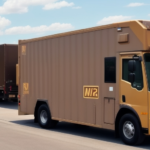Understanding UPS Shipping Rates
Shipping products efficiently and cost-effectively is essential for any business that sells physical goods. United Parcel Service (UPS) is one of the most popular shipping carriers worldwide, thanks in part to its reliable delivery and extensive service options. However, comprehending UPS shipping rates can be complex, especially when weight is a primary factor. This article delves into the intricacies of UPS shipping rates based on weight, providing valuable insights to help you optimize your shipping strategy and reduce costs.
Importance of Understanding UPS Shipping Rates for Your Business
Cost Management and Profitability
For businesses, managing shipping costs is crucial to maintaining profitability. UPS, being a major player in the shipping industry, offers a variety of pricing structures that can significantly impact your expenses. By thoroughly understanding UPS's pricing model, you can make informed decisions on packaging, shipping methods, and service levels to minimize costs.
Enhancing Customer Satisfaction
Accurate shipping rate calculations enable you to provide precise shipping quotes to your customers. Transparency in shipping costs fosters trust and can enhance customer satisfaction and loyalty. Moreover, offering multiple shipping options based on different rates allows customers to choose the service that best fits their needs and budget.
How UPS Determines Shipping Rates
Weight-Based Pricing
UPS calculates shipping rates primarily based on the weight of the package and the distance it must travel. Packages are categorized into weight breaks, and the rate increases as the weight category rises. For instance, UPS Ground shipping rates typically range from 1 lb to 150 lbs, with rates escalating with heavier weights.
Dimensional Weight Considerations
In addition to actual weight, UPS uses a concept called "dimensional weight" to account for the size of the package. This method calculates the billable weight based on the package's dimensions, ensuring that larger packages that take up more space are priced appropriately. Even lightweight packages can incur higher rates if they occupy significant space on delivery vehicles.
Shipping Zones
UPS divides shipping destinations into different zones based on the distance from the origin. The number of zones a package crosses influences the shipping rate, with more zones typically resulting in higher costs. Understanding these zones can help businesses optimize their shipping routes and choose the most cost-effective options.
Factors Influencing UPS Shipping Rates
Package Size and Dimensions
The dimensions of a package, along with its weight, play a critical role in determining the shipping cost. Larger packages consume more space, leading to higher rates due to increased dimensional weight charges.
Shipping Method
UPS offers various shipping methods such as Ground, Air, and International services. Each method has different pricing structures, delivery times, and reliability, catering to different business needs and budgets.
Destination Distance
The distance between the shipping origin and destination affects the rate. Longer distances typically incur higher shipping costs due to increased fuel and transportation expenses.
Additional Services
UPS provides optional services like insurance, signature confirmation, and Saturday delivery. While these services enhance the shipping experience, they also add to the overall cost.
Calculating UPS Shipping Rates
Using the UPS Rate Calculator
UPS offers an online Rate Calculator tool that allows businesses to estimate shipping costs based on package weight, dimensions, destination, and selected services. This tool is invaluable for budgeting and planning shipping expenses.
Understanding Dimensional Weight
To calculate dimensional weight, use the formula:
- Dimensional Weight = (Length × Width × Height) / 139
The result is compared to the actual weight, and UPS bills the higher of the two. For detailed guidelines, refer to UPS's dimensional weight policy.
Strategies to Save on UPS Shipping Costs
Optimize Package Weight and Size
Reducing the weight and size of packages can significantly lower shipping costs. Use lightweight packaging materials and ensure that your products are packed efficiently to minimize excess space.
Consolidate Shipments
Combining multiple orders into a single shipment can reduce the number of packages you send, leading to cost savings on shipping fees and packaging materials.
Select the Right Shipping Service
Choose the shipping service that best fits your delivery timeline and budget. For non-urgent deliveries, opting for UPS Ground can be more economical compared to expedited shipping options.
Leverage UPS Discounts
UPS offers discounts for businesses that have high shipping volumes or commit to long-term shipping contracts. Inquire with your UPS representative about available discount programs.
Common Mistakes to Avoid When Estimating UPS Shipping Rates
Underestimating Package Weight
Accurate weight measurement is essential. Underestimating the weight can lead to unexpected costs and delivery delays. Always use a reliable scale to measure your packages.
Ignoring Additional Fees
Be aware of potential surcharges such as residential delivery fees, fuel surcharges, and customs fees for international shipments. These can significantly impact the total shipping cost.
Inaccurate Package Dimensions
Incorrectly measuring package dimensions can result in higher dimensional weight charges. Ensure that you measure the length, width, and height of each package accurately.
Poor Packaging Practices
Using excessive packaging increases both weight and dimensional weight, leading to higher shipping costs. Invest in appropriate packaging solutions that protect your products without adding unnecessary bulk.
Negotiating and Optimizing Your UPS Shipping Rates
Negotiating Better Rates
If your business ships frequently with UPS, you may be eligible for negotiated rates. Contact a UPS sales representative to discuss your shipping volume and explore potential discounts tailored to your needs.
Choosing the Right Packaging
Selecting the appropriate packaging not only protects your products but also optimizes space and weight. Consider using standardized box sizes and lightweight materials to reduce shipping costs.
Implementing Shipping Software
Investing in shipping software can streamline your shipping process, provide better rate comparisons, and help you manage shipments more efficiently. Tools like ShipBob or ShipStation integrate with UPS to optimize your shipping strategy.
Conclusion
Understanding UPS shipping rates is pivotal for businesses aiming to manage expenses and enhance profitability. By comprehending how UPS calculates rates based on weight and other factors, you can make strategic decisions to optimize your shipping processes. Implement the strategies discussed, such as optimizing package size, consolidating shipments, and negotiating better rates, to reduce your shipping costs effectively. Staying informed and proactive in managing your shipping strategy will not only save money but also improve customer satisfaction and support your business’s growth.






















